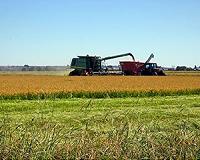 |
West Lafayette IN (SPX) Jan 18, 2011 Purdue University researchers have found a genetic mutation that allows a plant to better endure drought without losing biomass, a discovery that could reduce the amount of water required for growing plants and help plants survive and thrive in adverse conditions. Plants can naturally control the opening and closing of stomata, pores that take in carbon dioxide and release water. During drought conditions, a plant might close its stomata to conserve water. By doing so, however, the plant also reduces the amount of carbon dioxide it can take in, which limits photosynthesis and growth. Mike Mickelbart, an assistant professor of horticulture; Mike Hasegawa, a professor of horticulture; and Chal Yul Yoo, a horticulture graduate student, found that a genetic mutation in the research plant Arabidopsis thaliana reduces the number of stomata. But instead of limiting carbon dioxide intake, the gene creates a beneficial equilibrium. "The plant can only fix so much carbon dioxide. The fewer stomata still allow for the same amount of carbon dioxide intake as a wild type while conserving water," said Mickelbart, whose results were published in the early online version of the journal The Plant Cell. "This shows there is potential to reduce transpiration without a yield penalty." Mickelbart and Yoo used an infrared gas analyzer to determine the amount of carbon dioxide taken in and water lost in the Arabidopsis mutant. Carbon dioxide is pumped into a chamber with the plant and the analyzer measures the amount left after a plant has started to take up the gas. A similar process measures water lost through transpiration, in which water is released from a plant's leaves. Analysis showed that the plant, which has a mutant form of the gene GTL1, did not reduce carbon dioxide intake but did have a 20 percent reduction in transpiration. The plant had the same biomass as a wild type of Arabidopsis when its shoot dry weight was measured. "The decrease in transpiration leads to increased drought tolerance in the mutant plants," Yoo said. "They will hold more water in their leaves during drought stress." Of the 20 genes known to control stomata, SDD1 was highly expressed in the mutant. SDD1 is a gene that is responsible for regulating the number of stomata on leaves. In the mutant, with GTL1 not functioning, SDD1 is highly expressed, which results in the development of fewer stomata. Mickelbart said the finding is important because it opens the possibility that there is a natural way to improve crop drought tolerance without decreasing biomass or yield. He said the next step in the research is to determine the role of GTL1 in a crop plant.
Share This Article With Planet Earth
Related Links Purdue University Farming Today - Suppliers and Technology
 Food Prices Insulate Agriculture Sector From Wider Economy Woes
Food Prices Insulate Agriculture Sector From Wider Economy WoesWest Lafayette IN (SPX) Jan 18, 2011 Much of the U.S. economy has been slow to recover from the recession. That hasn't been true of farmland markets, which have continued to climb, a group of Purdue University agricultural economists says. Strong crop returns, very low interest rates and a growing expectation that both might continue have had a positive influence on farmland values, said Mike Boehlje, Chris Hurt and Brent Glo ... read more |
|
| The content herein, unless otherwise known to be public domain, are Copyright 1995-2010 - SpaceDaily. AFP and UPI Wire Stories are copyright Agence France-Presse and United Press International. ESA Portal Reports are copyright European Space Agency. All NASA sourced material is public domain. Additional copyrights may apply in whole or part to other bona fide parties. Advertising does not imply endorsement,agreement or approval of any opinions, statements or information provided by SpaceDaily on any Web page published or hosted by SpaceDaily. Privacy Statement |